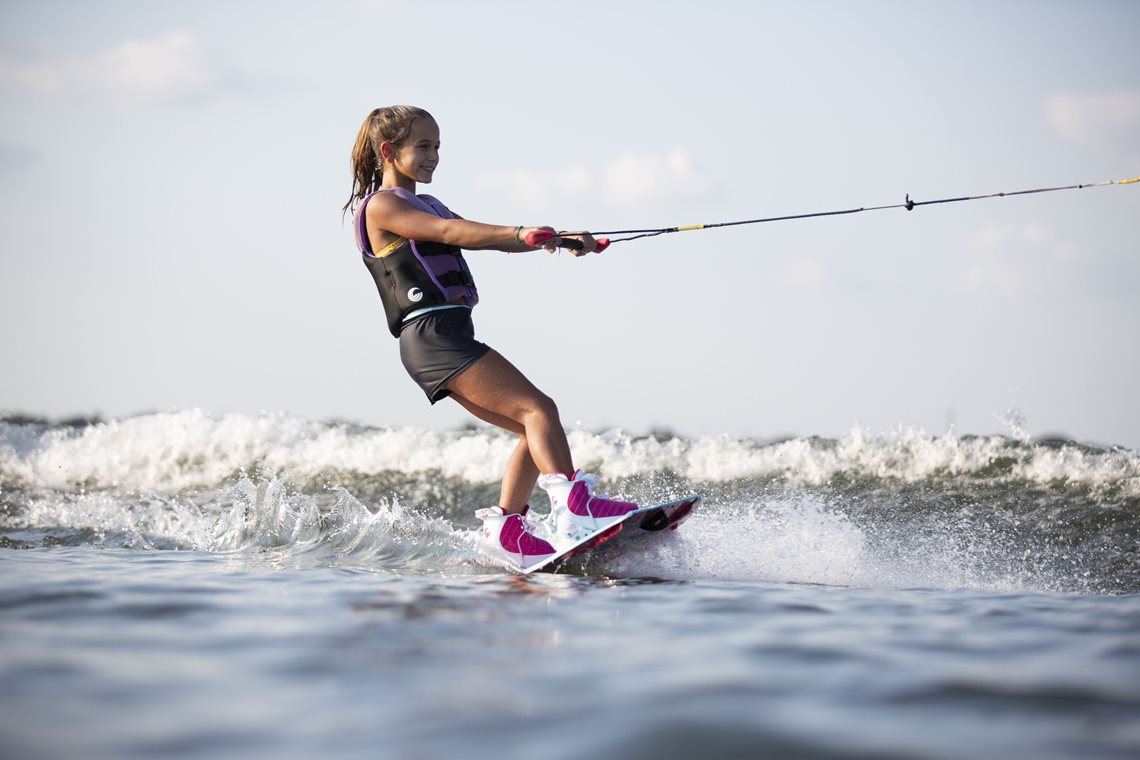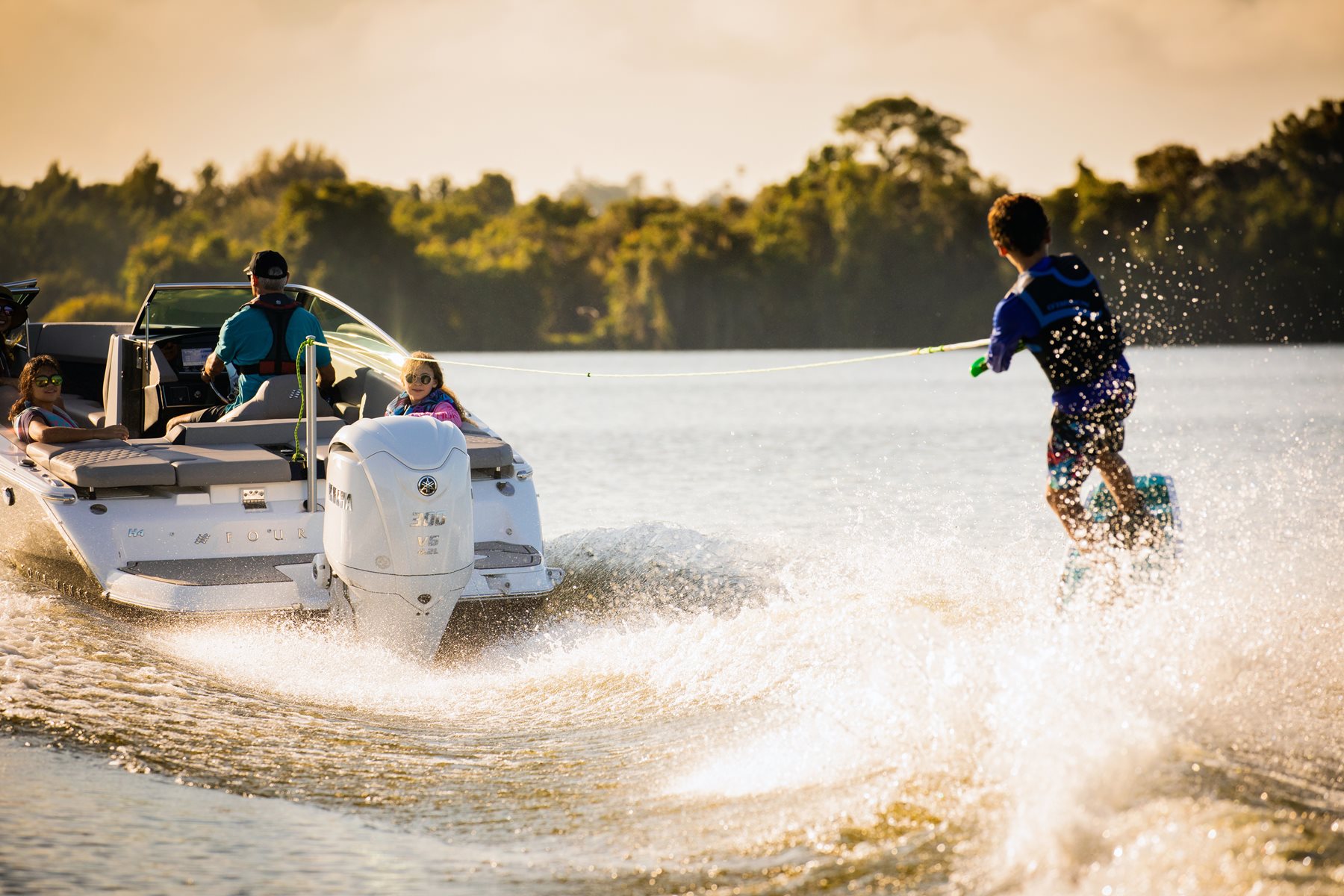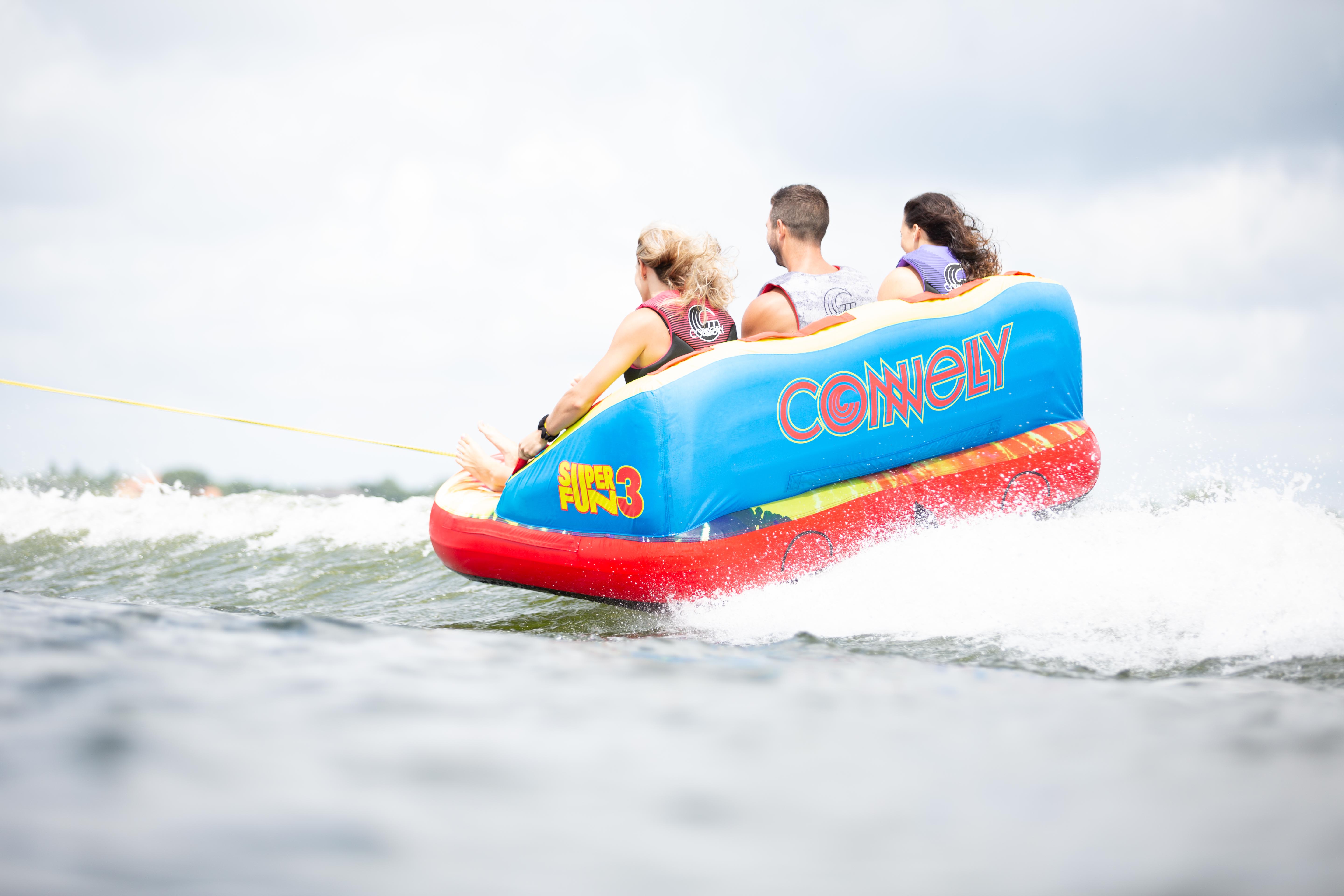Awareness, communication and sensitivity to what’s best for the skier/rider are three crucial areas to improve upon to become a better wake sports driver. Your goal is to adopt a towing mindset that promotes success, fun and safety.
Forget trying to make a skier/rider take a fall for some laughs. That’s a recipe for disaster on today’s crowded waterways. And get rid of distractions such as smartphones—they’re dangerous on the roads, and just as dangerous on the water. Focus on being the best driver you can be.
Nowadays all types of Yamaha outboard-powered boats can do double-duty as tow boats. Runabouts, bass boats, center consoles and pontoons are excellent for towing tubers, water skiers, wakeboarders and even barefoot water skiers.
However, driving for wake sports is not just steering and moving the throttle forward. Imagine the collaboration between the driver and the skier/rider as a beautiful dance, a true partnership for fun. The better the driver, the better the wake sports experience will be for the skier/rider and the passengers in the boat.

Key No. 1: 360-Degree Awareness
The driver should develop a high level of awareness around the boat, and a rearview mirror for the boat is a must. Aftermarket mirrors are available for runabouts, center consoles, bass boats and pontoons. Some mirrors provide a wider angle of view for the driver. The wider view lets the driver better keep an eye on the skier/rider behind the boat, especially when the boat is making a turn while pulling a skier/rider.
The mirror allows the driver to face forward while just moving the eyes slightly to observe the mirror to know what’s going on behind the boat. Turning the head to see what going on behind the boat is an unsafe practice. The mirror, along with the help of a designated spotter, will give the driver a 360-degree awareness of the waterway around the boat.
Before beginning the wake sports session, the driver should make sure the passengers are sitting in seats and never on the gunwale. The driver should also make sure passengers don’t have hands or feet near the tow line when towing wake sports.

Key No. 2: Clear Communications
Before the wake sports session begins, the driver should ask what type of acceleration and top speed the skier/rider wants. If the skier/rider is a beginner and doesn’t know, the driver should know the approximate speed for each wake sport. When the skier/rider is up on top of the water behind the boat, skier/rider can communicate to the driver and spotter via hand signals.
Once the skier/rider is in the water with the line stretched out, the driver should wait until the skier/rider is ready and, and the skier/rider gives the command, “in gear” and “hit it.” The “in gear” command tells the driver to put the throttle softly into forward gear to allow the line to tighten. Once the line is tight, and skier/rider gives the “hit it” command telling the driver to accelerate smoothly to the desired speed. The skier/rider should never use the command “no” and “go” as these words are easily confused. Instead of saying “no” the skier/rider should say “stop” if not ready to start. This tells the driver to put the throttle into neutral.
Key No. 3: Sensitivity to Safety and Success
When the skier/rider is on the swim platform, preparing to get into the water or when the skier/rider ends a wake sports session and is ready to come back into the boat, the driver should always turn off the outboard instead of leaving the outboard running in neutral. There are three reasons for this:
1: When the outboard is off, the driver eliminates any chance of the throttle being placed in gear to engage the propeller while the skier is near the propeller of the outboard motor.
2: When the outboard is off, the skier/rider near the outboard will not be breathing any emissions from the outboard.
3: When the outboard is off, there is less noise, making conversing between the driver and skier/rider easier. With the outboard turned off, the driver should turn the outboard away from the boarding side of the swim platform, so the skier/rider uses the ladder to climb back into the boat instead of trying to step on the anti-ventilation plate above the propeller to get back into the boat. Always stay away from the propeller even when the outboard is turned off.
When towing a skier/rider, the driver should always accelerate and decelerate smoothly. In addition, the driver should keep an eye on the speedometer to make sure boat speed is constant to what the skier/rider desires.
Unless you have to make a turn, driving a straight line provides the best tow conditions for the skier/rider. A straight boat path keeps the boat’s wake even and uniform, which makes crossing the wake on a slalom ski or jumping the boat’s wake on a wakeboard much more fun.

When turning the boat with a skier/rider in tow, always make smooth turns and never intentionally try to throw a tube rider from a tube during a turn. It’s one thing to give a tube rider a fun, exciting ride and another thing to try to throw someone from the tube. As a wake sports driver, always drive on the side of being safe.
Like any other skill, you will improve with more time on the water. However, the key to getting better as a driver for wake sports is to continuously develop your sensitivity to having the skier/rider have a successful, fun and safe experience behind the boat. And when you do this, not only will the skier/rider have fun, you will enjoy the gratifying feeling of being a part of the success.
Back to Blue Life
Forget trying to make a skier/rider take a fall for some laughs. That’s a recipe for disaster on today’s crowded waterways. And get rid of distractions such as smartphones—they’re dangerous on the roads, and just as dangerous on the water. Focus on being the best driver you can be.
Nowadays all types of Yamaha outboard-powered boats can do double-duty as tow boats. Runabouts, bass boats, center consoles and pontoons are excellent for towing tubers, water skiers, wakeboarders and even barefoot water skiers.
However, driving for wake sports is not just steering and moving the throttle forward. Imagine the collaboration between the driver and the skier/rider as a beautiful dance, a true partnership for fun. The better the driver, the better the wake sports experience will be for the skier/rider and the passengers in the boat.
Key No. 1: 360-Degree Awareness
The driver should develop a high level of awareness around the boat, and a rearview mirror for the boat is a must. Aftermarket mirrors are available for runabouts, center consoles, bass boats and pontoons. Some mirrors provide a wider angle of view for the driver. The wider view lets the driver better keep an eye on the skier/rider behind the boat, especially when the boat is making a turn while pulling a skier/rider.
The mirror allows the driver to face forward while just moving the eyes slightly to observe the mirror to know what’s going on behind the boat. Turning the head to see what going on behind the boat is an unsafe practice. The mirror, along with the help of a designated spotter, will give the driver a 360-degree awareness of the waterway around the boat.
Before beginning the wake sports session, the driver should make sure the passengers are sitting in seats and never on the gunwale. The driver should also make sure passengers don’t have hands or feet near the tow line when towing wake sports.

Key No. 2: Clear Communications
Before the wake sports session begins, the driver should ask what type of acceleration and top speed the skier/rider wants. If the skier/rider is a beginner and doesn’t know, the driver should know the approximate speed for each wake sport. When the skier/rider is up on top of the water behind the boat, skier/rider can communicate to the driver and spotter via hand signals.
Once the skier/rider is in the water with the line stretched out, the driver should wait until the skier/rider is ready and, and the skier/rider gives the command, “in gear” and “hit it.” The “in gear” command tells the driver to put the throttle softly into forward gear to allow the line to tighten. Once the line is tight, and skier/rider gives the “hit it” command telling the driver to accelerate smoothly to the desired speed. The skier/rider should never use the command “no” and “go” as these words are easily confused. Instead of saying “no” the skier/rider should say “stop” if not ready to start. This tells the driver to put the throttle into neutral.
Key No. 3: Sensitivity to Safety and Success
When the skier/rider is on the swim platform, preparing to get into the water or when the skier/rider ends a wake sports session and is ready to come back into the boat, the driver should always turn off the outboard instead of leaving the outboard running in neutral. There are three reasons for this:
1: When the outboard is off, the driver eliminates any chance of the throttle being placed in gear to engage the propeller while the skier is near the propeller of the outboard motor.
2: When the outboard is off, the skier/rider near the outboard will not be breathing any emissions from the outboard.
3: When the outboard is off, there is less noise, making conversing between the driver and skier/rider easier. With the outboard turned off, the driver should turn the outboard away from the boarding side of the swim platform, so the skier/rider uses the ladder to climb back into the boat instead of trying to step on the anti-ventilation plate above the propeller to get back into the boat. Always stay away from the propeller even when the outboard is turned off.
When towing a skier/rider, the driver should always accelerate and decelerate smoothly. In addition, the driver should keep an eye on the speedometer to make sure boat speed is constant to what the skier/rider desires.
Unless you have to make a turn, driving a straight line provides the best tow conditions for the skier/rider. A straight boat path keeps the boat’s wake even and uniform, which makes crossing the wake on a slalom ski or jumping the boat’s wake on a wakeboard much more fun.

When turning the boat with a skier/rider in tow, always make smooth turns and never intentionally try to throw a tube rider from a tube during a turn. It’s one thing to give a tube rider a fun, exciting ride and another thing to try to throw someone from the tube. As a wake sports driver, always drive on the side of being safe.
Like any other skill, you will improve with more time on the water. However, the key to getting better as a driver for wake sports is to continuously develop your sensitivity to having the skier/rider have a successful, fun and safe experience behind the boat. And when you do this, not only will the skier/rider have fun, you will enjoy the gratifying feeling of being a part of the success.
Back to Blue Life
